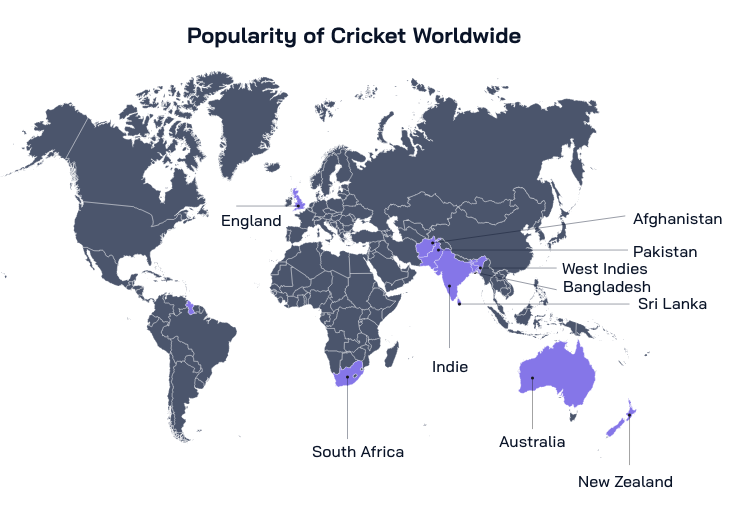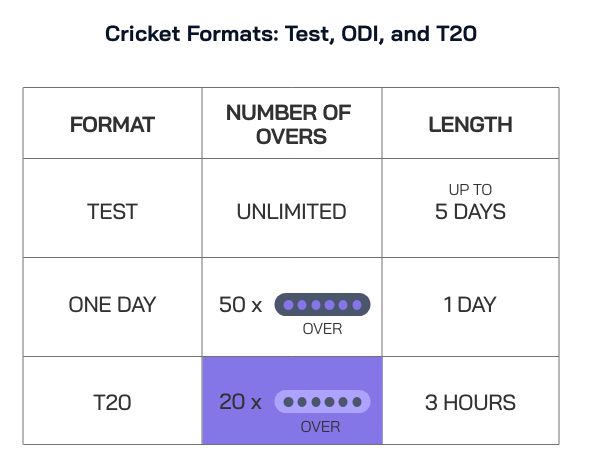Beloved or Utterly Unknown: The Global Asymmetry of Cricket’s Popularity
Cricket – either you are a devoted fan or you know nothing about it. How is it possible that cricket is the second most popular sport in the world after football? It’s simple! This incredibly long, dynamic, and unpredictable game grabs your heart and holds it tighter than a batsman’s grip on a cricket bat. In which other sport do players take a break for tea, and in which other sport did the longest match last 12 days? Exactly, only in cricket!
The Origins and Evolution of Cricket
Cricket is one of the oldest sports in the world, still played today. Its origins date back to at least 16th century England, and despite the elegant English attire, it is said that the sport originated from boys throwing a ball through a hole in a gate. The main factor in the global popularisation of cricket was the British Empire implementing its colonial strategy. In India, Australia, South Africa, Pakistan, Bangladesh, New Zealand, the Caribbean, and Sri Lanka, cricket is considered the national sport, and its fans are almost its worshippers. The immense emotions that accompany the game may be linked to the fact that in colonial countries, playing cricket was an opportunity to beat the colonisers at their own game. It is said that every country wants to give England a bit of a beating by playing cricket against them.

It is said that there are no rules in cricket, only laws. This is because the code that specifies the worldwide rules of cricket is called ‘the Laws of Cricket’. It was first written down in the 18th century at Lord’s Cricket Ground, London – considered the cradle of cricket. The rules of cricket are very complex, and have evolved over time. Currently the third revision of the seventh code is in effect, and it consists of 42 Laws.
In the most prestigious form of cricket, called the Test format, matches can stretch up to 5 days. Unlike other formats, there’s no limit on the number of turns (overs) each team gets to bat (bowl). This marathon style of play might explain why the English players, famous for their love of tea, incorporated dedicated tea and lunch breaks into the game!
The Inception of One Day Internationals
For a long time Test cricket remained the pinnacle of the sport, however, matches that could last for days, made the sport inaccessible and not a popular sport to watch. To make the competitions more accessible, a new game format, “One Day Internationals (ODIs),” was introduced. Here the number of overs is limited, leading to games which would be a lot shorter, although they could still last up to 7 hours!
With the growing popularity of the sport worldwide and this new tournament friendly format, the first World Cup was organised in 1975. India quickly became a cricket powerhouse, and on the wave of undisputed victories and dominance over England, elevated the sport to a quasi-religious status.
On the other hand, English fans did not share this enthusiasm. Their fervour waned with each defeat, losing to various countries in significant competitions. The West Indies, India, Australia, Pakistan, and Sri Lanka became powerhouses in this sport, winning world championships and establishing strong teams that dominated the competition against England and other countries.
England had to act! Research showed that the declining popularity of cricket in England was also due to the inaccessibility and exclusivity of the sport. In these crisis conditions, the third format of cricket, twenty20 (T20), was born. In this version, the match was shortened to three hours, with 20 overs per team allowed. The new rules were introduced in 2005 during the first international T20 match between New Zealand and Australia.

The Rise of T20 and the Indian Premier League
India was initially against the transition to the T20 format. At the World Cup in Johannesburg (South Africa) in 2007, they sent a team composed of young players. They played Pakistan in the final, attracting a massive audience, with an estimated viewership of around a billion people worldwide! The match between India and Pakistan was a milestone in cricket history, bringing the T20 format into the mainstream. What seemed impossible happened: India, with a population of 1.4 billion, went even crazier about cricket than teenagers at a Taylor Swift concert.
This led to the creation of the Indian Premier League (IPL) in 2008. The love of Indians for cricket became even more obvious in the first two years, as team owners, including Bollywood stars like Preity Zinta and Shahrukh Khan, saw the value of the IPL doubled from 2 to over 4 billion dollars.
Cultural and Political Impact of Cricket Stars
Cricket stars have had a tremendous impact on society, culture, and politics, inspiring millions and shaping national identity in their countries. In cricket, the most popular position is the batsman, whose main task is to score runs by hitting the ball. Batsmen are the most recognizable and often the most popular players, similar to forwards in football.
Sir Vivian Richards, known as one of the greatest batsmen in cricket history, was friends with Bob Marley, the reggae music legend. While Marley didn’t write a specific song about Richards, his songs often contained references to cricket. Many calypso artists, such as Mighty Sparrow and Lord Kitchener, created songs celebrating outstanding cricketers, including Richards, praising his skills and achievements on the field (“Viva Viv Richards”).
Sachin Tendulkar (India), known as the “God of Cricket,” is one of the greatest batsmen in cricket history and a symbol of national pride and unity in India. He was also a member of the Rajya Sabha, the upper house of the Indian parliament. He wasn’t the only one that pursued a political career, but so did Imran Khan (Pakistan) – the legendary all-rounder and captain of the team that won the 1992 World Cup. He founded the political party Tehreek-e-Insaf and served as the Prime Minister of Pakistan from 2018 to 2022. In August 2023, he was sentenced to 3 years in prison on corruption charges.
Corruption in Cricket
Unfortunately, corruption in cricket has sparked more than one scandal, and India once had to face serious challenges in this regard. In 2000, the biggest match-fixing scandal in cricket history erupted. It turned out that Hansie Cronje (captain of the South African national cricket team) and Mohammad Azharuddin (captain of the Indian national cricket team) were selling matches to bookmakers.
In India, chaos ensued among fans, who began burning effigies of Azhar on the streets and staging protests. The Indian Central Bureau of Investigation asked for the opinion of three retired Supreme Court judges on whether charges could be brought against them. Because betting was illegal in India, match-fixing wasn’t a crime. Nothing could be done, and as a result, many people stopped watching cricket. Eventually, the BCCI (Board of Control for Cricket in India) had to punish the players involved in the scandal.
Record-Breaking Feats and Enduring Traditions
As you can see, the world of cricket never gets boring, and there are even more fascinating and interesting stories. The longest cricket match in history took place in 1939 between England and South Africa in Durban. The match lasted 12 days and ended in a draw because the English team had to catch a ship back to England. After 12 days of the match, I would be in a hurry to get home too, especially if the journey took two to three weeks by ship.
Besides the longest journeys home, cricketers are also good at setting impressive records. Brian Lara of the West Indies set the record for the highest individual score in a test match, scoring ‘400 not out’ against England. The match took place in April 2004 at the Antigua Recreation Ground in St John’s, Antigua. Setting such a record is no easy feat, as to score 400 runs, Lara had to spend many hours on the field, requiring immense physical and mental endurance. Lara set this record at a time when test cricket was undergoing many changes and modernization, making his achievement even more impressive.
The Continued Appeal of Test Cricket
Don’t be fooled by appearances! Test matches are still being played. Yes – those long five-day, seemingly endless matches where players wear traditional white attire and play with a red ball. Test cricket is considered the ultimate test of a player’s skills, endurance, and mental strength. So if cricket has piqued your interest and you want to see what it looks like live and experience the emotions associated with a multi-day cricket match of high importance, I have a surprise for you.
From Wednesday, August 21 to Sunday, August 25, 2024, the first test match between England and Sri Lanka will take place at Emirates Old Trafford in Manchester. Each day of play is divided into three sessions: morning, afternoon, and evening, with breaks for lunch and tea. The second test will take place between August 29 and September 2, 2024, and the third between September 5 and 10, 2024. During the lunch break on the first day of the match, there will be a special presentation to honour James Anderson’s career. Anderson, a native of Lancashire, is one of the greatest fast bowlers in cricket history. So, it promises to be full of attractions!
The Global Popularity of Cricket
Cricket’s appeal goes deeper than just having a large fanbase, which is huge in countries with populations of hundreds of millions. The strategic complexities and mind games involved over the course of a match keep fans engaged and enthralled, demanding a level of skill and planning that transcends simple athleticism.
